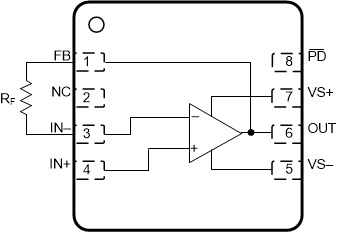ZHCSI18A April 2018 – July 2018 OPA858
PRODUCTION DATA.
9.3.2 Feedback Pin
The OPA858 pin layout is optimized to minimize parasitic inductance and capacitance, which is critical in high-speed analog design. The FB pin (pin 1) is internally connected to the output of the amplifier. The FB pin is separated from the inverting input of the amplifier (pin 3) by a no connect (NC) pin (pin 2). The NC pin must be left floating. There are two advantages to this pin layout:
- A feedback resistor (RF) can connect between the FB and IN– pin on the same side of the package (see Figure 49) rather than going around the package.
- The isolation created by the NC pin minimizes the capacitive coupling between the FB and IN– pins by increasing the physical separation between the pins.
 Figure 49. RF Connection Between FB and IN– Pins
Figure 49. RF Connection Between FB and IN– Pins